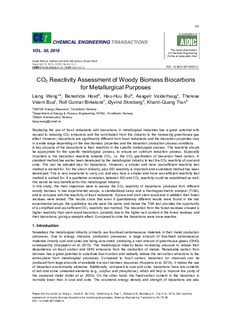CO2 reactivity assessment of woody biomass biocarbons for metallurgical purposes
Wang, Liang; Hovd, Benedicte; Bui, Hau-Huu; Valderhaug, Aasgeir Mikael; Videm Buø, Therese; Birkeland, Rolf Gunnar; Skreiberg, Øyvind; Tran, Khanh-Quang
Journal article, Peer reviewed
Published version

View/
Date
2016Metadata
Show full item recordCollections
Abstract
Replacing the use of fossil reductants with biocarbons in metallurgical industries has a great potential with respect to reducing CO2 emissions and the contribution from this industry to the increasing greenhouse gas effect. However, biocarbons are significantly different from fossil reductants and the biocarbon properties vary in a wide range depending on the raw biomass properties and the biocarbon production process conditions. A key property of the biocarbons is their reactivity in the specific metallurgical process. The reactivity should be appropriate for the specific metallurgical process, to ensure an optimum reduction process. Especially important is the biocarbon reactivity towards CO2, i.e. the CO2 gasification of biocarbon fixed carbon. A standard method has earlier been developed by the metallurgical industry to test the CO2 reactivity of coal and coke. This can be adopted also for biocarbons. However, a simpler and more cost-efficient reactivity test method is wished for. For the silicon industry, also SiO reactivity is important and a standard method has been developed. This is very expensive to carry out, and also here a simpler and more cost-efficient reactivity test method is wished for. If a qualitative correlation between SiO and CO2 reactivity could be established as well, this would be very beneficial for this metallurgical industry. In this study, the main objectives were to assess the CO2 reactivity of biocarbons produced from different woody biomass in two experimental setups, a standardized setup and a thermogravimetric analyser (TGA), and to compare with the reactivity of fossil reductants. Spruce and birch stem wood and in addition their forest residues were tested. The results show that even if quantitatively different results were found in the two experimental setups, the qualitative results were the same, and hence the TGA test provides the opportunity of a simplified and cost-efficient CO2 reactivity test method. The biocarbon from the forest residues showed a higher reactivity than stem wood biocarbon, probably due to the higher ash content in the forest residues and their biocarbons, giving a catalytic effect. Compared to coke the biocarbons were more reactive.